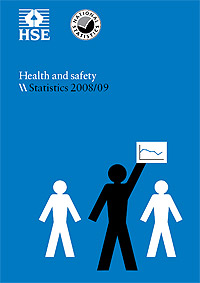HSE Claims UK Safest Place To Work In EU
Britain is one of the safest places to work in the EU, the HSE is claiming, following the release of its latest statistics on the number of people killed, injured, or made ill at work last year.
 The figures for April 2008 to March 2009 confirm the provisional total of work-related deaths released in June as 180 – the lowest level ever recorded – but also reveal a reduction of 7000 in the number of serious and over-three-day injuries, and a 13-per-cent drop in working days lost to injury and ill health, compared with the previous year’s figures.
The figures for April 2008 to March 2009 confirm the provisional total of work-related deaths released in June as 180 – the lowest level ever recorded – but also reveal a reduction of 7000 in the number of serious and over-three-day injuries, and a 13-per-cent drop in working days lost to injury and ill health, compared with the previous year’s figures.
These are the main points from the statistics:
* 1.2 million people who worked during the last year were suffering from an illness (long standing as well as new cases) they believed was caused or made worse by their current or past work. 551 000 of these were new cases.
* 180 workers were killed at work, a rate of 0.6 per 100 00 workers.
* 131 895 other injuries to employees were reported under RIDDOR, a rate of 502.2 per 100 000 employees.
*
246 000 reportable injuries occurred, according to the Labour Force Survey, a rate of 870 per 100 000 workers.
* 29.3 million days were lost overall (1.24 days per worker), 24.6 million due to work-related ill health and 4.7 million due to workplace injury.
Reporting this news in the Safety & Health Practitioner, their article adds:
"Britain now has the lowest rate of fatal injuries in the EU, at 1.3 deaths per 100,000 workers, compared with the EU average of 2.5.
Acknowledging that the recession – and consequent fall in activity levels and the number of people in work – has partly contributed to these figures, HSE chair Judith Hackitt emphasised that the challenge now is to maintain the downward trends as the economy improves."
She is quoted as saying:
“Protecting people from harm caused by work remains important, irrespective of the economic climate. History suggests that when we start moving back into economic growth the rate of work-related injuries will tend to increase. Preventing history from repeating itself is a challenge facing everyone with a stake in health and safety in the workplace – regulators, employers and employees alike.”
IOSH president Nattasha Freeman welcomed the fall in fatalities and injuries but urged the HSE not to be complacent:
“It is critical that the HSE don’t take their foot off the accelerator – there are still far too many accidents and cases of workplace ill health in this country, which could be prevented from happening in the first place. We need to keep focusing on the industries of greatest risk, like construction and agriculture, and ensure that the number of accidents in these sectors continues to decline."
She added: “We also want government to press on with plans to get a million people off incapacity benefit and back into the workplace, because we know that good work is good for you. We also need to encourage employers to promote well-being and help employees achieve a work-life balance – that’s the only way to tackle Britain’s worker ill-health epidemic.”
Source: SHP / HSE